Innovative approach to car park renovation
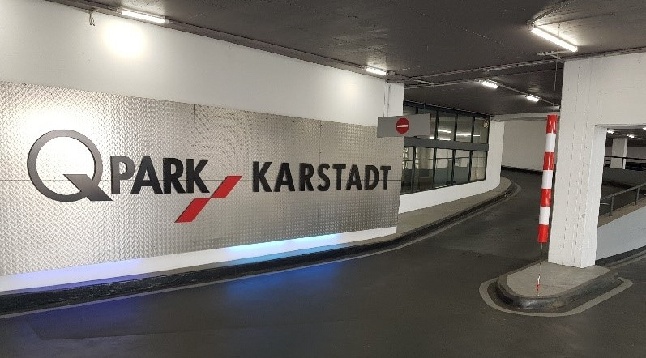
Karstadt car park, Bielefeld
Karstadt is one of the largest car parks in the German city of Bielefeld. Built in 1965 using reinforced concrete, it has nine split parking levels, with a total gross area of ≈ 19,000 m².
Q-Park acquired Karstadt in 2009, fitting the car park out with our eye-catching branding and upgrading it to the level of quality we are renowned for. Years later, a major refurbishment was necessary as holes opened up in the reinforced concrete floor and corrosion was found throughout the reinforcement.
At the time of construction, it was not common practice to protect components in the way it is today. Exposed concrete allowed de-icing salts from cars to penetrate the structure easily and attack the internal reinforcement, compromising the structural stability.
Q-Park’s real estate team identified the problems and, together with a specialist planner, came up with a clever way to renovate the site.
The refurbishment proved hugely challenging, as the car park was frequently busy and open around the clock, so the loss of parking spaces had to be kept to a minimum. Completely closing the car park was simply not an option.
Cracks and spalling were found throughout the entire structure, which meant that a dangerous amount of de-icing salts (chlorides) had already penetrated the structure. In some cases, the corrosion was so bad that some parts had been completely dissolved.
The refurbishment involved securing the static load-bearing capacity and strengthening the building with a cathodic corrosion protection system, doing away with the need for another such large-scale refurbishment in the future.
Carbon-fibre reinforced concrete with cathodic corrosion protection, developed by Koch GmbH, was used as it ticked both boxes.
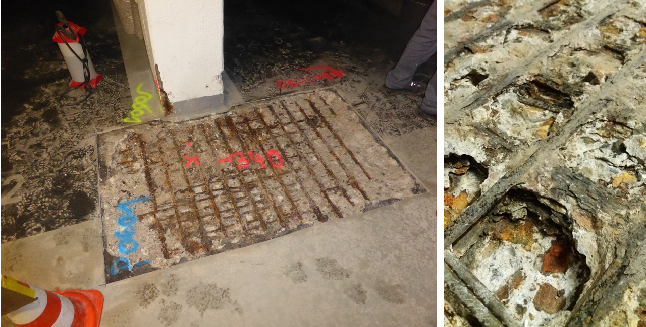
Some of the reinforcement had completely dissolved due to pitting corrosion
Innovative maintenance plan
Typically, damaged concrete is removed using high-pressure water jetting (HPWJ). The reinforcement is then added and new concrete is poured. But the bracing support required on every level would have meant that the multi-storey car park would have had to be shut entirely for several months – something that was out of the question for Q-Park.
Instead, a combination of different systems was chosen to replace the reinforcement, with added cathodic corrosion protection. Structural steel, glass fibre composite reinforcement and carbon scrims were used for static restoration, with the scrims also being used as an anode for the cathodic corrosion protection.
Titanium strip anodes were also used. The advantage of carbon-fibre reinforced concrete with cathodic corrosion protection is that it compensates for the loss of cross-sectional reinforcement, it strengthens the structure and, at the same time, it protects the existing reinforcement against chloride from the de-icing salts.
The existing mastic asphalt, including the floor coating, was removed from the entire surface and a suitable carbon scrim was selected. The carbon used boasts an array of excellent properties, including resistance to corrosion and oxidation. And since it requires less concrete coverage than reinforcing steel, this method also saved on additional materials. Moreover, the structure was coated with a rigid, long-lasting OS 8 sealant and protected against wear.
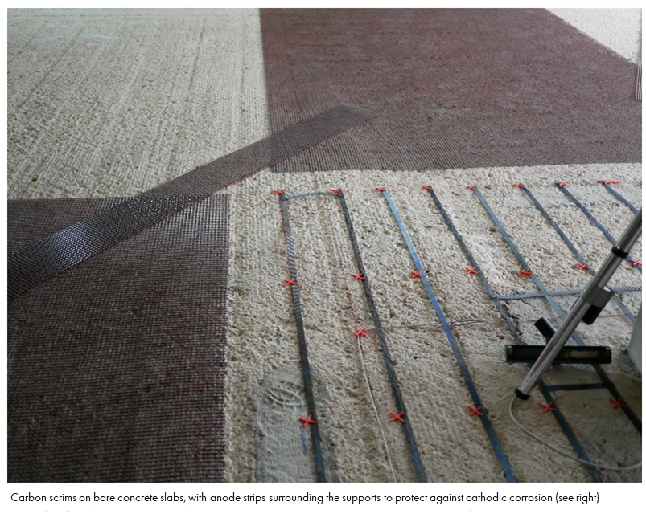
Carbon scrims on bare concrete slabs, with anode strips surrounding the supports to protect against cathodic corrosion (on the right)
New parking space layout
The old narrow parking spaces were widened to at least 2.30 m, and in places where that was not possible due to the support columns, two parking spaces were merged to form one extra-wide space. These changes have improved parking comfort and now offer enough room for SUVs to park.
Originally, Karstadt had 643 parking spaces. Today there are 568 parking spaces of which 28 XXL and 16 dedicated for blue badge holders.
The entire parking space layout, floor plans and traffic routes were redesigned and implemented by our in-house experts in line with contemporary standards. Then, we applied the classic Q-Park touches, including the uniform black pads denoting the parking spaces and Q-Park colour scheme.
Finally, an energy-saving LED lighting system with light control was installed on all parking levels, as well as in the stairwells.
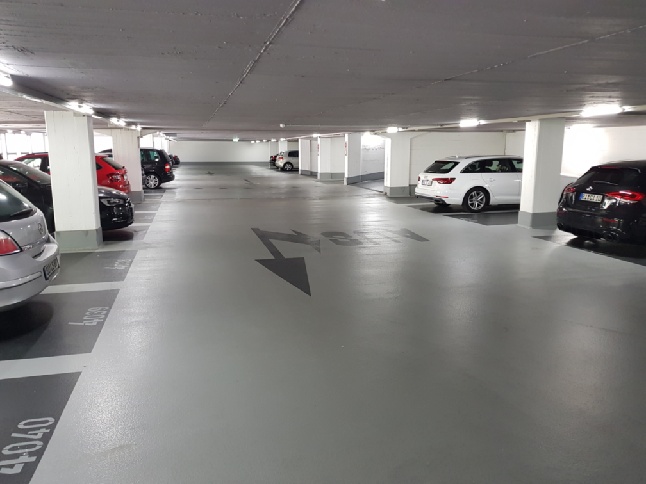
New floor coating and space layout
Renovation in phases
To keep disruption to a minimum, the construction sections were divided into 12 sub-sections, and work was carried out from top to bottom. A complex traffic control system with traffic lights was temporarily installed – sometimes over three levels – and staff were deployed in the access and exit areas to ensure safety.
Compact construction phases were chosen in order to minimise the impact on customers, which meant that the renovation lasted from September 2017 to June 2020.
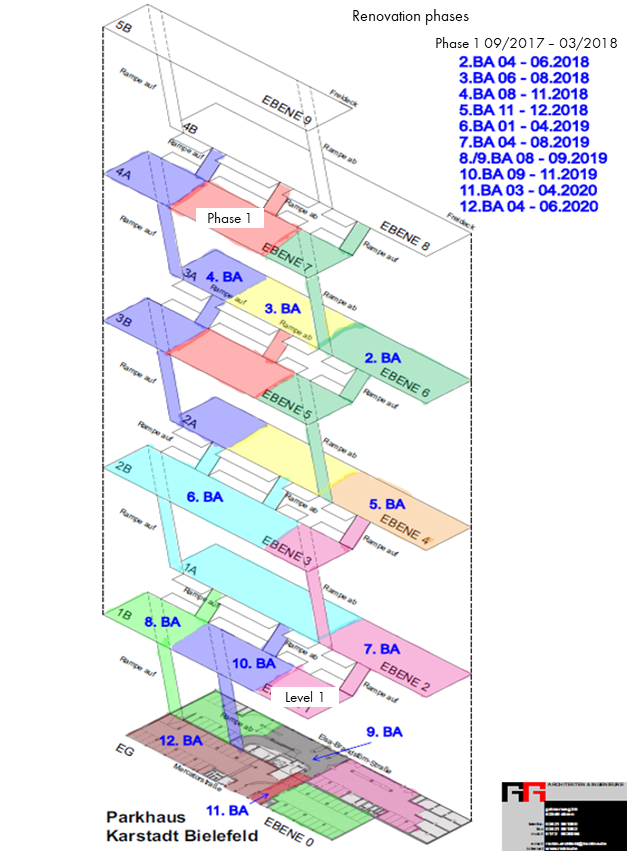
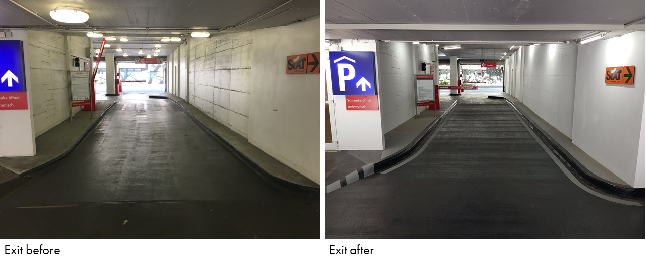
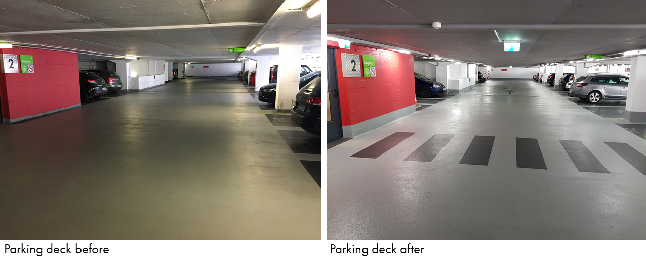
The entire redevelopment is a huge success, even though during the work some tasks and challenges only continued to grow. The entire renovation went smoothly thanks to the excellent cooperation with the construction firms Koch GmbH, Massenberg GmbH in Essen, Instakorr GmbH and Sika Deutschland GmbH, specialist planner Plan2 Hallmann and its partner, consulting engineers IKBauNW.
For 2021 we are looking at renovating the facade, finalising the whole renovation with having a splendid look and feel, both inside and out.
Would you like to learn more about our innovative car park renovation? Does your car park need redeveloping or refurbishing?
Our experts are happy to advise and support you. Please get in touch or leave a comment.
